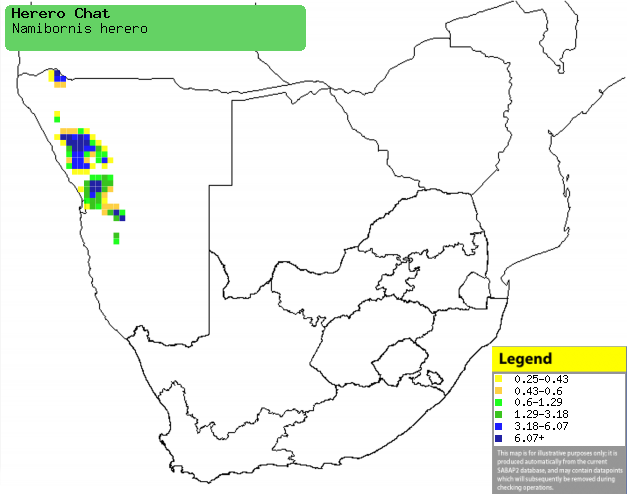|
Namibornis herero (Herero chat)
Hererospekvreter [Afrikaans]; Herero-tapuit [Dutch]; Namiorne héréro
[French]; Namibschnäpper [German]; Chasco de Herero [Portuguese]
Life
> Eukaryotes >
Opisthokonta
> Metazoa (animals) >
Bilateria >
Deuterostomia > Chordata >
Craniata > Vertebrata (vertebrates) > Gnathostomata (jawed
vertebrates) > Teleostomi (teleost fish) > Osteichthyes (bony fish) > Class:
Sarcopterygii (lobe-finned
fish) > Stegocephalia (terrestrial
vertebrates) > Tetrapoda
(four-legged vertebrates) > Reptiliomorpha > Amniota >
Reptilia (reptiles) >
Romeriida > Diapsida > Archosauromorpha > Archosauria >
Dinosauria
(dinosaurs) > Saurischia > Theropoda (bipedal predatory dinosaurs) >
Coelurosauria > Maniraptora > Aves
(birds) > Order: Passeriformes
> Family: Muscicapidae
Distribution and habitat
Near-endemic to southern Africa occurring from the extreme
south-west of Angola through to the western half of Namibia. Here it is locally
common on inselbergs and escarpments with scattered Acacia, bush-cherry (Maerua),
corkwood (Commiphora) and cluster-leaf (Terminalia) trees,
especially along drainage lines.
|
 |
|
Distribution of Herero chat in southern Africa,
based on statistical smoothing of the records from first SA Bird Atlas
Project (©
Animal Demography unit, University of
Cape Town; smoothing by Birgit Erni and Francesca Little). Colours range
from dark blue (most common) through to yellow (least common). |
Food
It mainly eats insects (especially ants and termites),
doing some of its foraging from a perch in the shade, pouncing on prey on the
ground and occasionally in the air. It also searches for food on the ground,
inspecting the bases of bushes and shrubs and digging for small insects. The following food items have been recorded
in its diet:
- Arthropods
- Berries of Commiphora saxicola (Rock corkwood)
- Seeds
Breeding
- The nest is built by both sexes in about 3-4 days, at first stuffing
grassy material into a crack or cavity in a tree, or between the branches of
a fork. Rootlets, thin bark strips and plant fibres are then incorporated in
the structure, and both birds mould it with their bodies to form an open
cup. It is typically placed at the base of a tree's canopy, especially if it
is positioned by itself near a rocky outcrop, at the bottom of a slope or
near drainage lines.
- Egg-laying season is from February-March, often coinciding with rain.
- It lays 2-3 eggs, which are incubated mainly by the female for about 16
days, all the while eating a lot of Rock corkwood berries (Commiphora
saxicola)
- The chicks are fed by both parents, leaving the nest after about 12-16
days, after which they follow they parents when they go and forage. They
usually become fully independent around 3-5 months after fledging.
Threats
Not threatened.
References
-
Hockey PAR, Dean WRJ and Ryan PG 2005. Roberts
- Birds of southern Africa, VIIth ed. The Trustees of the John Voelcker
Bird Book Fund, Cape Town.
|
